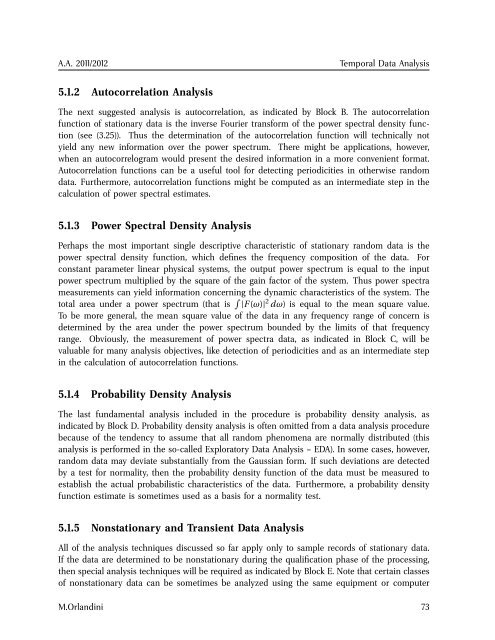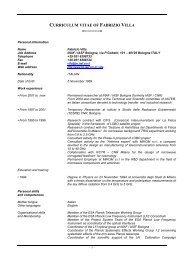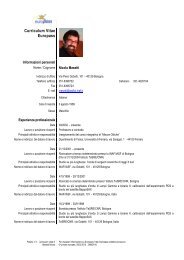booklet format - inaf iasf bologna
booklet format - inaf iasf bologna
booklet format - inaf iasf bologna
You also want an ePaper? Increase the reach of your titles
YUMPU automatically turns print PDFs into web optimized ePapers that Google loves.
A.A. 2011/2012<br />
Temporal Data Analysis<br />
5.1.2 Autocorrelation Analysis<br />
The next suggested analysis is autocorrelation, as indicated by Block B. The autocorrelation<br />
function of stationary data is the inverse Fourier transform of the power spectral density function<br />
(see (3.25)). Thus the determination of the autocorrelation function will technically not<br />
yield any new in<strong>format</strong>ion over the power spectrum. There might be applications, however,<br />
when an autocorrelogram would present the desired in<strong>format</strong>ion in a more convenient <strong>format</strong>.<br />
Autocorrelation functions can be a useful tool for detecting periodicities in otherwise random<br />
data. Furthermore, autocorrelation functions might be computed as an intermediate step in the<br />
calculation of power spectral estimates.<br />
5.1.3 Power Spectral Density Analysis<br />
Perhaps the most important single descriptive characteristic of stationary random data is the<br />
power spectral density function, which defines the frequency composition of the data. For<br />
constant parameter linear physical systems, the output power spectrum is equal to the input<br />
power spectrum multiplied by the square of the gain factor of the system. Thus power spectra<br />
measurements can yield in<strong>format</strong>ion concerning the dynamic characteristics of the system. The<br />
total area under a power spectrum (that is ∫ |F (ω)| 2 dω) is equal to the mean square value.<br />
To be more general, the mean square value of the data in any frequency range of concern is<br />
determined by the area under the power spectrum bounded by the limits of that frequency<br />
range. Obviously, the measurement of power spectra data, as indicated in Block C, will be<br />
valuable for many analysis objectives, like detection of periodicities and as an intermediate step<br />
in the calculation of autocorrelation functions.<br />
5.1.4 Probability Density Analysis<br />
The last fundamental analysis included in the procedure is probability density analysis, as<br />
indicated by Block D. Probability density analysis is often omitted from a data analysis procedure<br />
because of the tendency to assume that all random phenomena are normally distributed (this<br />
analysis is performed in the so-called Exploratory Data Analysis – EDA). In some cases, however,<br />
random data may deviate substantially from the Gaussian form. If such deviations are detected<br />
by a test for normality, then the probability density function of the data must be measured to<br />
establish the actual probabilistic characteristics of the data. Furthermore, a probability density<br />
function estimate is sometimes used as a basis for a normality test.<br />
5.1.5 Nonstationary and Transient Data Analysis<br />
All of the analysis techniques discussed so far apply only to sample records of stationary data.<br />
If the data are determined to be nonstationary during the qualification phase of the processing,<br />
then special analysis techniques will be required as indicated by Block E. Note that certain classes<br />
of nonstationary data can be sometimes be analyzed using the same equipment or computer<br />
M.Orlandini 73

















